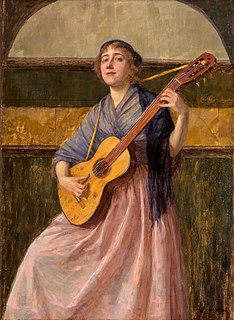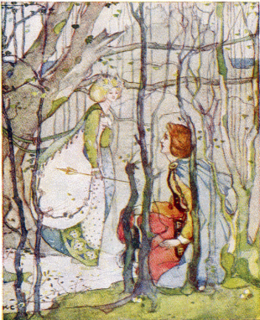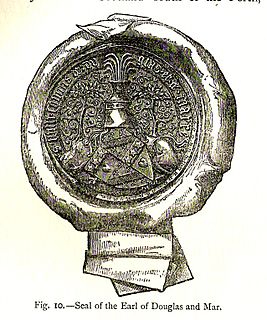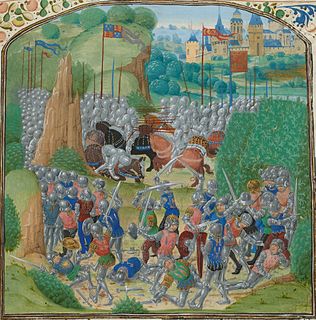Related Research Articles

A ballad is a form of verse, often a narrative set to music. Ballads derive from the medieval French chanson balladée or ballade, which were originally "dance songs". Ballads were particularly characteristic of the popular poetry and song of Britain and Ireland from the Late Middle Ages until the 19th century. They were widely used across Europe, and later in Australia, North Africa, North America and South America. Ballads are often 13 lines with an ABABBCBC form, consisting of couplets of rhymed verse, each of 14 syllables. Another common form is ABAB or ABCB repeated, in alternating eight and six syllable lines.

Sir Thomas de Ercildoun, better remembered as Thomas the Rhymer, also known as Thomas Learmont or True Thomas, was a Scottish laird and reputed prophet from Earlston in the Borders. Thomas' gift of prophecy is linked to his poetic ability.

The Yarrow Water is a river in the Borders in the south east of Scotland. It is a tributary of the Ettrick Water and renowned for its high quality trout and salmon fishing. The name "Yarrow" may derive from the Celtic word garw meaning "rough" or possibly share a derivation with the English name "Jarrow".

"The Ballad of Chevy Chase" is an English ballad, catalogued as Child Ballad 162. There are two extant ballads under this title, both of which narrate the same story. As ballads existed within oral tradition before being written down, other versions of this once popular song also may have existed. Moreover, other ballads used its tune without necessarily having any connection to "The Ballad of Chevy Chase".
The Percy Folio is a folio book of English ballads used by Thomas Percy to compile his Reliques of Ancient Poetry. Although the manuscript itself was compiled in the 17th century, some of its material goes back well into the 12th century. It was the most important of the source documents used by Francis James Child for his 1883 collection The English and Scottish Popular Ballads.

Thomas Percy was Bishop of Dromore, County Down, Ireland. Before being made bishop, he was chaplain to George III of the United Kingdom. Percy's greatest contribution is considered to be his Reliques of Ancient English Poetry (1765), the first of the great ballad collections, which was the one work most responsible for the ballad revival in English poetry that was a significant part of the Romantic movement.

Sir James Douglas, 2nd Earl of Douglas and Mar was an influential and powerful magnate in the Kingdom of Scotland.

The Battle of Otterburn took place according to Scottish sources on 5 August 1388, or 19 August according to English sources, as part of the continuing border skirmishes between the Scots and English.

Otterburn is a small village in Northumberland, England, 31 miles (50 km) northwest of Newcastle upon Tyne on the banks of the River Rede, near the confluence of the Otter Burn, from which the village derives its name. It lies within the Cheviot Hills about 16 miles (26 km) from the Scottish border. The parish of Otterburn is at the heart of Redesdale, a Northumbrian upland valley.

A broadside is a single sheet of inexpensive paper printed on one side, often with a ballad, rhyme, news and sometimes with woodcut illustrations. They were one of the most common forms of printed material between the sixteenth and nineteenth centuries, particularly in Britain, Ireland and North America and are often associated with one of the most important forms of traditional music from these countries, the ballad.

The Reliques of Ancient English Poetry is a collection of ballads and popular songs collected by Bishop Thomas Percy and published in 1765.
The Heir of Linne is a traditional folk song existing in several variants.
"The Maid and the Palmer" is an English language murder ballad with supernatural/religious overtones. Because of its dark and sinister lyrics, the song was often avoided by folk singers. Child's main text comes from the seventeenth century ballad collection compiled by Thomas Percy, supplemented by a nineteenth century fragment recalled by Sir Walter Scott, although scholars believe that the original English language version of the ballad is considerably older, and derives from a Continental original dealing with a medieval legend associated with Mary Magdalene. The ballad was present in oral tradition in Scotland in the early years of the nineteenth century but was subsequently lost there, however versions have since been recovered in Ireland, in particular among the Irish Traveller community, with an intervening gap of some 150 years. A small fragment of the ballad has also been claimed to have been recovered in the U.S.A., but the veracity of this record is disputed.

Minstrelsy of the Scottish Border is an anthology of Border ballads, together with some from north-east Scotland and a few modern literary ballads, edited by Walter Scott. It was first published in 1802, but was expanded in several later editions, reaching its final state in 1830, two years before Scott's death. It includes many of the most famous Scottish ballads, such as Sir Patrick Spens, The Young Tamlane, The Twa Corbies, The Douglas Tragedy, Clerk Saunders, Kempion, The Wife of Usher's Well, The Cruel Sister, The Dæmon Lover, and Thomas the Rhymer. Scott enlisted the help of several collaborators, notably John Leyden, and found his ballads both by field research of his own and by consulting the manuscript collections of others. Controversially, in the editing of his texts he preferred literary quality over scholarly rigour, but Minstrelsy of the Scottish Border nevertheless attracted high praise from the first. It was influential both in Britain and on the Continent, and helped to decide the course of Scott's later career as a poet and novelist. In recent years it has been called "the most exciting collection of ballads ever to appear."

"The Dowie Dens o Yarrow", also known as "The Braes of Yarrow" or simply "Yarrow", is a Scottish border ballad. It has many variants and it has been printed as a broadside, as well as published in song collections. It is considered to be a folk standard, and many different singers have performed and recorded it.
"King John and the Bishop" is an English folk-song dating back at least to the 16th century. It is catalogued in Child Ballads as number 45 and Roud Folk Song Index 302.
The Battle of Sark, alternatively called the Battle of Lochmaben Stone, was fought between England and Scotland in October 1448. A large battle, it was the first significant Scottish victory over the English in over half a century, since the Battle of Otterburn in 1388. It placed the Scots in a position of strength against the English for over a decade, until Edward IV ascended the English throne, and it brought the powerful Douglas family to even greater prominence in Scotland.

Northumberland Betrayed By Douglas is Child ballad 176. It has a Roud Folk Song Index number of 4006. It tells of the Seventh Earl of Northumberland fleeing to Scotland.
References
- ↑ Child, Francis James (1889). The Battle of Otterburn. The English and Scottish Popular Ballads. Vol. 3, Part 2 (=Part VI). Houghton Mifflin. pp. 289–303.
- 1 2 See here.
- ↑ Prebble, John (1981). The lion in the North: a personal view of Scotland's history (snippet). Penguin books. ISBN 0140056459. ISBN 9780140056457
- ↑ Scott 1803 , 2, 28
- ↑ Child 1889 , 3, p. 289
- ↑ Diana Newton (2006). North-East England, 1569-1625: Governance, Culture and Identity. Boydell Press. p. 144. ISBN 978-1-84383-254-6.
- ↑ Scott, Walter (1803). Minstrelsy of the Scottish Border. Vol. 1. James Ballantyne. pp. 27–47.
- ↑ Child 1889 , 3, p. 295